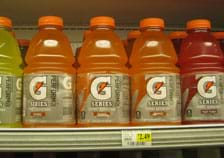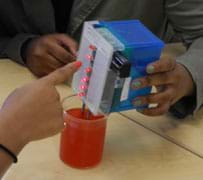Materials List:
What's the Conductivity of Gatorade?
 https://www.teachengineering.org/activities/view/nyu_gatorade_activity1
https://www.teachengineering.org/activities/view/nyu_gatorade_activity1

Each group needs:
- ~5 grams sodium chloride (if not available, use Kosher salt), to make its own calibration solutions
- ~2.5 - 3 liters water, to make its own set of calibration solutions
- 7-8 cups or beakers (this includes individual cups for the solutions needed for the calibration curve, plus 1-2 cups for the unknown solutions)
- BASIC Stamp conductivity meter (created by teacher, in advance, see below); alternatively, use a standalone conductivity meter or a multimeter (set to measure resistance, with a few modifications using a spacer and some tape, see the Procedure section)
- ruler
- Conductivity of Gatorade Worksheet, one per student
To share with the entire class:
- ~500 ml Gatorade of each of three (or more) flavors, enough of each to adequately immerse the probe
- ~500 ml pickle juice, any kind, enough to adequately immerse the probe
- sodium chloride (or Kosher salt), to make ~500 ml of an "unknown" salt solution for students to test

The BASIC Stamp conductivity meter, a device created by the teacher in advance of the activity.
To make a BASIC Stamp conductivity meter (estimated cost: $53):
- BASIC Stamp Activity Kit - Serial + USB (Text v.3.0) ($50, includes the HomeWork Board with a built-in BASIC Stamp 2 microcontroller, LEDs, wires, resistors and capacitors; item code 90005, available from parallax.com)
- computer (system requirements for PC: Pentium 133 mhz or higher, 32 MB RAM, VGA display; for MAC: G3 or higher with 64 MB RAM, color display)
- BASIC Stamp editor software (latest version for your operating system, free download available from Parallax Inc at http://www.parallax.com/Support/DownloadsPress/tabid/477/Default.aspx)
- (5) 550 Ω resistors (included in BASIC Stamp Activity Kit)
- 20 kΩ resistor (included in BASIC Stamp Activity Kit)
- 1 μF capacitor (included in BASIC Stamp Activity Kit)
- 22 AWG wire (included in BASIC Stamp Activity Kit)
- (5) LEDs, any color (included in BASIC Stamp Activity Kit)
- 555 Timer IC CMOS ($2 each, item code: 604-00009; available from parallax.com)
- (2) 5-inch 4/40 stainless steel screws
- (4) 4/40 nylon nuts
- roll of electrical tape
- hack saw
- Fisherbrand® SureOne™ pipette tip rack (100μl–1000μl size) (This is the empty container that is usually thrown out once all the tips are used. For this activity, it serves as a neat and tidy housing for the circuitry. As such, it is difficult to put a price on it; a case of these tips costs $65 and includes 10 racks.)
- BD Falcon 50 ml conical centrifuge tube with screw caps ($337 per case of 500, catalog number: 14-432-24; available from Fisher Scientific [www.fishersci.com])
- (4) zip ties
- drill, to make two holes in the cap
- Conductivity Meter Building and Calibration Instructions
 https://www.teachengineering.org/activities/view/nyu_gatorade_activity1
https://www.teachengineering.org/activities/view/nyu_gatorade_activity1